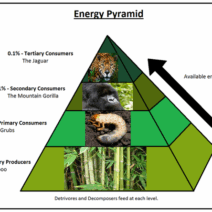The intricate tapestry of life on Earth is meticulously woven through a network of interactions among various organisms. At the core of this ecosystemic interplay lies the concept of trophic levels, a hierarchical system that illustrates how energy flows through the biological community. Understanding how energy is conserved between these levels is essential for grasping the broader implications of ecosystem health and sustainability. This article delves deep into the intricacies surrounding energy transfer and conservation across trophic levels, demonstrating how nature’s energy ladder functions.
The trophic levels can generally be categorized into primary producers, primary consumers, secondary consumers, and tertiary consumers, with each level representing a distinct role in the ecosystem. The primary producers, typically consisting of autotrophic organisms like plants and phytoplankton, harness solar energy through photosynthesis, converting it into chemical energy stored in organic matter. This foundational level forms the bedrock of energy flow.
Moving to the next rung of the energy ladder, primary consumers—herbivores such as deer, rabbits, and various insects—derive their energy by consuming the primary producers. However, despite their capacity to feed off plants, not all of the energy contained within the plants is converted into biomass. It is estimated that only about 10% of the energy consumed by primary consumers is transformed into their own biological mass. This phenomenon, known as the 10% Rule, elaborates on energy inefficiencies that occur during trophic transfer.
As energy ascends to secondary consumers—carnivores that prey on primary consumers—further losses occur. The energy transfer between these levels is subject to the same limitations, with approximately only 10% of the energy from primary consumers being utilized for growth, reproduction, and maintenance in secondary consumers. Thus, by the time energy reaches the tertiary consumers—top predators like eagles, wolves, or large sharks—only a fraction of the original energy captured by autotrophs remains available. The cumulative effects of energy dissipation ultimately mean that a mere 0.1% of the solar energy initially harnessed by producers becomes available to apex predators.
The mechanisms behind energy loss at each trophic level are multifaceted. Metabolic processes such as respiration, growth, reproduction, and movement demand energy. Additionally, inefficiencies in digestion and assimilation further exacerbate the loss. For example, not all parts of a plant are digestible; leaves, stems, and roots may not be fully utilized. Waste materials, such as feces, also contribute to energy loss, as they represent unabsorbed organic matter. Collectively, these factors contribute to a significant reduction in energy as it traverses through the food web.
To illustrate the concept of energy conservation across trophic levels, the energy pyramid serves as a useful visual tool. This pyramid graphically represents the decreasing amount of energy available at each level. The base of the pyramid, depicting primary producers, occupies the widest segment, while subsequent tiers become progressively narrower, symbolizing the diminishing energy availability for higher trophic levels. This shape is a vivid reminder of the intertwined nature of ecosystems and the reliance of higher trophic levels on robust populations of producers and primary consumers.
The implications of energy conservation between trophic levels extend beyond mere ecological curiosity. They punctuate the importance of maintaining biodiversity and ecosystem services. As energy flows through the trophic levels, it not only sustains individual species but also fosters interactions among organisms, maintaining ecosystem stability. Biodiversity supports ecosystem resilience, allowing ecological systems to recover from disturbances and adapt to changes such as climate change, habitat destruction, and pollution.
Examining energy transfer also sheds light on the ramifications of human activity on ecological networks. Overexploitation of resources, habitat fragmentation, pollution, and climate change severely disrupt the delicate balance of energy flow. For instance, overfishing impacts fish populations and consequently undermines the energy dynamics for the secondary and tertiary consumers that depend on these fish. Similarly, deforestation diminishes primary productivity, stripping ecosystems of their energy foundation, and resulting in cascading effects across all trophic levels.
Conservation efforts aimed at preserving energy flow within ecosystems play a crucial role in combating the effects of climate change. Strategies such as establishing protected areas, restoring habitats, and adopting sustainable agricultural practices are pivotal for maintaining biodiversity. By ensuring the health of primary producers, these efforts empower ecosystems to deliver vital services, such as carbon sequestration, nutrient cycling, and pollution filtration, effectively mitigating climate change.
Moreover, public awareness and education are monumental in the context of conservation. By fostering a broadened understanding of ecological interconnections, initiatives can empower communities to engage in sustainable practices, such as reducing waste, supporting local agriculture, and protecting natural resources. Building a culture of environmental stewardship is indispensable for ensuring the sustainability of our planet’s energy dynamics.
The transfer and conservation of energy across trophic levels form a foundational component of ecological systems. With less than one-tenth of energy passing through each step of the energy pyramid, the importance of each level cannot be overstated. By recognizing the critical interplay between trophic levels and advocating for environmental preservation, we can contribute to a healthier planet. In a world facing unprecedented challenges, understanding, protecting, and enhancing nature’s energy ladder seems imperative for mitigating the effects of climate change and sustaining life on Earth.






